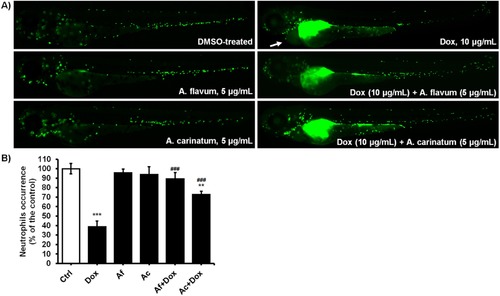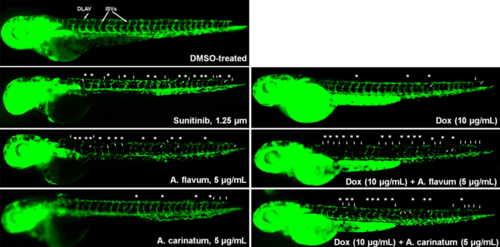- Title
-
Wild edible onions - Allium flavum and Allium carinatum - successfully prevent adverse effects of chemotherapeutic drug doxorubicin
- Authors
- Pavic, A., Dragana, M.Ć., Nebojša, J., Biljana, N., Nataša, S., Branka, V., Jelena, K.V.
- Source
- Full text @ Biomed. Pharmacother.
|
The time-dependent protective effect of Allium extracts on Dox-induced whole body toxicity (A) and cardiotoxicity (B, C) in zebrafish embryos. Embryos were treated with Dox (10 μg/ml) at 6 hpf and extracts (5 μg/ml) at a different time up to 48 hpf. When applied up to 36 hpf, both extracts rescued Dox-treated embryos from skeletal deformities (A) and pericardial edema (B); but if applied at 48 hpf, embryos developed pericardial edema (arrow), malformed head (bracket), jaw (dashed arrow) and otoliths (boxed), and scoliosis (arrowhead). Cardioprotective effect of Allium extracts has also been manifested by the improved heartbeat rate of Dox-treated embryos, as evaluated at 96 hpf (C). Data are presented as the mean ± SD of three independent experiments. Statistically significant difference in the heartbeat rate between the Dox-treated group and the control group (### P < 0.001), and between embryos upon the combination treatments and Dox alone (*** P < 0.001) are denoted. |
|
Myeloprotective effect of Allium extracts against Dox toxicity in Tg(mpx:EGFP) zebrafish embryos. Neutrophils occurrence (A) and the fluorescence intensity (B) upon different treatments are shown. While Dox caused severe neutrophils depletion (neutropenia) and large pericardial edema (arrow) at 10 μg/ml, extracts applied at a dose of 5 μg/ml had no toxic effect on neutrophils, while exerted both myeloprotective and cardioprotective effect in the combination treatments. Strong fluorescence in the yolk sac region in Dox-treated embryos originates from Dox accumulation. Statistically significant differences in neutrophil occurrence between the control (0.1% DMSO-treated) group and the groups upon single treatments (*P < 0.5, **P < 0.01; ***P < 0.001), and between the Dox-treated group and the groups upon the combination treatments (#P < 0.5, ##P < 0.01; ###P < 0.001) are denoted. |
|
In vivo anti-angiogenic effect of Allium extracts applied alone (A and B) and in combination with Dox (C). Effects of the treatments on intersegmental vessels (ISVs) and dorsal longitudinal anastomotic vessels (DLAVs), as well as on subintestinal vessels (SIVs) development in Tg(fli1:EGFP) zebrafish embryos were assessed at 48 hpf and 72 hpf, respectively. Normally developed ISVs, DLAVs and SIVs are designated in the control (0.1% DMSO-treated) embryo, while disrupted DLAVs (asterisk), thinner or reduced ISVs (arrow) and reduced SIVs (arrowhead) are designated upon applied treatments. Statistically significant differences in ISVs length between the control group and the groups upon treatments (***P < 0.001) as well as between the Dox-treated group and the groups upon the combination treatments (###P < 0.001) are denoted. |
|
The toxicity evaluation of doxorubicin (Dox) and A. flavum and A. carinatum extracts in zebrafish embryos expressed as the LC50 values. Data are presented as the mean ± SE of three independent experiments with 20 embryos per concentration. Morphology of zebrafish embryos at 96 hpf exposed to 30 µg/mL of A. flavum and A. carinatum extracts (normal embryos) and 10 µg/mL Dox (seriously malformed embryos) are shown. Embryos upon 10 µg/mL of Dox suffered from large pericardial edema (arrow) and body edema (empty arrowhead), were reduced in the growth and yolk consumption (asterisk), had malformed head (bracket), jaw (dashed arrow) and otoliths (boxed), and scoliosis (black arrowhead) |
|
The dose-dependent inhibition of SIVs and ISVs angiogenesis in zebrafish embryos treated with A. flavum and A. carinatum extracts. ISVs angiogenesis was inspected at 48 hpf (right photos showing whole embryos), while SIVs angiogenesis was evaluated at 72 hpf (left photos showing head and arrow-labeled SIVs). Sunitinib-malate (1.25 µM) and auranofin (1.25 µM), clinically approved drugs with anti-angiogenic properties, were used positive controls and caused serious pericardial edemas (dashed arrow |
|
Improved angiogenesis inhibitory effect of the combination treatment of Dox with extracts in zebrafish embryos compared to the single treatments, as assessed at 48 hpf. Embryos with anti-angiogenic phenotype had disrupted DLAVs (asterisk) and/or thinner or reduced ISVs (arrow). SIVs development was not possible to analyze due to strong fluorescence caused by Dox accumulation in the yolk sac region. Sunitinib (1.25 µM) was used as a positive control |






